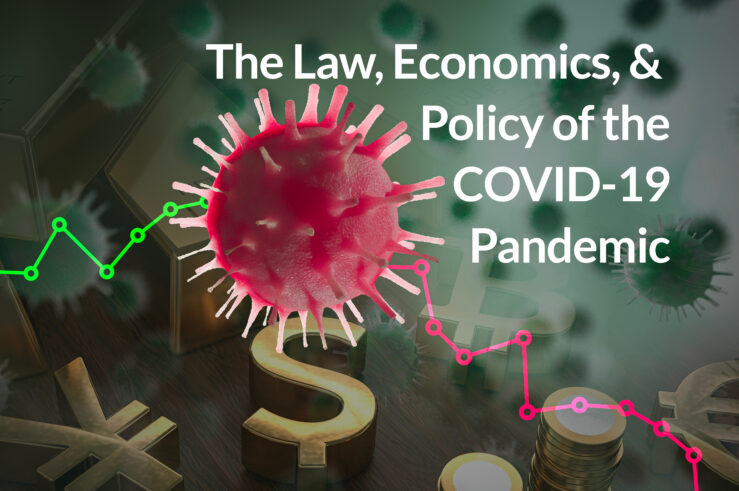
This article is a part of the The Law, Economics, and Policy of the COVID-19 Pandemic symposium.
Summary: Trying to quarantine everyone until a vaccine is available doesn’t seem feasible. In addition, restrictions mainly delay when the epidemic explodes, e.g., see previous post on Flattening the Curve. In this paper, we propose subsidies to both individuals and businesses, to better align private incentives with social goals, while leaving it up to individuals and businesses to decide for themselves which risks to take.
For example, testing would give individuals the information necessary to make the best decision about whether to shelter in place or, if they have recovered and are now immune, to come out. But, the negative consequences of a positive test, e.g., quarantine, can deter people from getting tested. Rewards for those who present for a test and submit to isolation when they have active disease could offset such externalities.
Another problem is that many people aren’t free on their own to implement protective measures related to work. Some form of incentive for work from home, closing down production in some part, or extra protection for workers could be imagined for employers. Businesses that offer worker health care might be incentivized by sharing in the extra virus health care costs realized by workers in exchange for a health care subsidy.
Essay: In the midst of an epidemic it is evident that social policy must adjust in furtherance of the public good. Institutions of all sorts, not the least of which government, will have to take extraordinary actions. People should expect their relationships with these institutions to change, at least for some time. These adjustments will need to be informed by applicable epidemiological data and models, subject to the usual uncertainties. But the problems to be faced are not only epidemiological but economic. There will be tradeoffs to be made between safer, restrictive rules and riskier, unconstrained behaviors. Costs to be faced are both social and individual. As such, we should not expect a uniform public policy to make suitable choices for all individuals, nor assume that individuals making good decisions for themselves will combine for a good social outcome. Imagine instead an alternative, where social costs are evaluated and appropriate individual incentives are devised, allowing individuals to make informed decisions with respect to their own circumstances and the social externalities reflected in those incentives.
We are currently in the US at the beginning of the coronavirus epidemic. This is not the flu. It is maybe ten times as lethal as the flu, perhaps a little more lethal proportionally in the most susceptible populations. It is new, so there is little or no natural immunity, and no vaccine available for maybe 18 months. Like the flu, there is no really effective treatment yet for those that become sickest, particularly because the virus is most deadly through the complications it causes with existing conditions, so treatment options should not perhaps be expected to help with epidemic spread or to reduce lethality. It is spread relatively easily from person to person, though not as easily as the measles, perhaps significantly before the infected person shows symptoms. And it may be that people can get the virus, become contagious and spread the disease, while never showing symptoms themselves. We now have a test for active coronavirus, though it is still somewhat hard to get in the US, and we can expect at some point in the near future to have an antibody test that will show when people either have or have had and recovered from the virus.
There are some obvious social and individual costs to people catching this virus. First there are the deaths from the disease. Then there are the costs of treating those ill. Finally, there are costs from the lost productivity of those fallen ill. If there is a sudden and extreme increase in the numbers of sick people, all of these costs can be expected to rise, perhaps significantly. When hospitals have patients in excess of existing capacity, expanding capacity will be difficult and expensive, and death rates can be expected to rise.
An ideal public health strategy in the face of an epidemic is to keep people from falling sick. At the beginning of the epidemic, the few people with the disease need to be found and quarantined, and those with whom they have had contact need to be traced and isolated so that any carrying the disease can be stopped from passing it on. If there is no natural reservoir of disease that reintroduces the disease, it may be possible to eradicate the disease. When there were few cases, this might have been practical, but that effort has clearly failed, and there are far too many carriers of the disease now to track.
Now the emphasis must be on measures to reduce transmission of the disease. This entails modifying behaviors that facilitate the disease passing from person to person. If the rate of infection can be reduced enough, to the point where the number of people each infected person can be expected to infect is less than one on average, then the disease will naturally die out. Once most people have had the disease, or have been vaccinated, most of the people an infected person would have infected are immune so the rate of new infections will naturally fall to less than one and the disease will die out. Because so many people have immunity to many varieties of the flu, its spread can be controlled in particular through vaccination, the only difficulty being that new strains are appearing all of the time. The difficulty with coronavirus is that simple measures for reducing the spread of the disease do not seem to be effective enough and extreme measures will be much more expensive. Moreover, because the coronavirus is a pandemic, even if one region succeeds in reducing transmission and has the disease fade, reintroduction from other regions can be expected to relight the fire of epidemic. Measures for reducing transmission will need to be maintained for some time, likely until a vaccine is available or natural heard immunity is established through the majority of the population having had the disease.
The flu strikes every year and we seem to tolerate it without extreme measures of social distancing. Perhaps there’s nothing that needs to be done now, nothing worth doing now, to slow the coronavirus epidemic. But what would the cost of such an attitude be? The virus would spread like wildfire, infecting in a matter of months perhaps the majority of the population. Even with an estimate of 70 to 150 million Americans, at a 1% death rate that means 0.7 to 1.5 million would die. But that many cases all at once would overwhelm the medical system, and the intensive care required to keep the death rate even this low. A surge in cases might mean an increase in death rate.
At the other extreme, we seem to be heading into a period where everyone is urged to shelter-in-place, or required to be locked down, so as to reduce social contacts to near zero and thereby interrupt the spread of the virus. This may be effective, perhaps even necessary to prevent an immediate surge of demand on hospitals. But it is also expensive in the disruptions it entails. The number of active infections can be drastically reduced over a time scale corresponding to an individual’s course of the disease. Removing the restrictions would mean then that the epidemic resumes from the new lower level with somewhat more of the population already immune. It seems unlikely the disease can be eradicated by such measures because of the danger of reintroduction from other regions where the virus is active. The strategy of holding everyone in this isolation until a vaccine becomes available isn’t likely to be palatable. Releasing restrictions slowly so as to keep the level of the disease at an acceptable level would likely mean that most of the population would get the disease before the vaccine became available. Even if the most at risk population remained isolated, the estimated death rate over the majority of the population implies a nontrivial number of deaths. How do we decide how many and who to risk in order to get the economy functioning?
Consider then a system of incentives to individuals to help communicate the social externalities and guide their decisions. If there is a high prevalence of active disease in the general population, then hospitals will see excessive demand and it will be unsafe for high risk individuals to expose themselves to even minimal social interactions. A low prevalence of active disease can be more easily tolerated by hospitals, with a lower resulting death rate, and higher risk individuals may be more able to interact and provide for themselves. To promote a lower level of disease, individuals should be incentivized to delay getting sick, practicing social distancing and reducing contacts in a trade-off with ordinary necessary activity and respecting their personal risk category and risk tolerance. This lower level of disease is the “flattening of the curve”, but it also imagines the most at risk segment of the population might choose to isolate for a longer term, hoping to hold out for a vaccine.
If later disease or no disease is preferable, how do we incentivize it? Can we at the same time incentivize more usual infection control measures? Eventually everyone will either need to take an antibody test, to determine that they have had the disease and developed immunity and so are safe to resume all normal activities, or else need the vaccination. People may also be tested for active disease. We can’t penalize people for showing up with active disease, as this would mean they would skip the test and likely continue infecting other people. We should reward those who present for a test and submit to isolation when they have active disease. We can reward also those who submit to the antibody test and test positive (for the first time) who can then resume normal activities. On the other hand, we want people to delay when they get sick through prudent measures. Thus it would be a good idea to increase over time the reward for first showing up with the disease. To avoid incentivizing delay in testing, the reward for a positive test should increase as a function of the last antibody test that was negative, i.e., the reward is more if you can prove you had avoided the disease as of your last antibody test. The size of the rewards should be significant enough to cause a change of behavior but commensurate with the social cost savings induced. If we are planning on giving Americans multiple $1000 checks to get the economy going anyway, then such monies could be spent on incentives alternatively. This imagines antibody testing will be available, relatively easy and inexpensive in maybe three months, and antibody tests might be repeated maybe every three months. And of course this assumes the trajectory of the epidemic can be controlled well enough in the short term and predicted well enough in the long term to make such a scheme possible.
HT: Colleague Steven Tschantz
This post originally appeared on the Managerial Econ Blog




